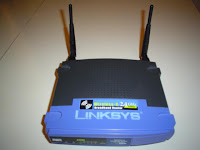Linksys WRT54G dwe can make the server as a gateway for Internet connection that we have, we may have to provide the server pc so that the cost should we provide will be more expensive. For configuration WRT54G This is not too difficult. The steps: If you choose to disable the DHCP then you must enter the IP, Netmask, Gateway and DNS manually for each client.
- Turn Linksys Router WRT54G.
- By using the UTP cable that has been provided (Straight cable UTP) cable to plug in a computer or notebook while in the Router port to plug in a LAN.
- Set the IP in the computer / notebook into a DHCP and will usually get the IP automatically from the Router.
- Then see the IP obtained by the computer / notebook.
- using a browser, the browser address bar enter the ip gateway computer (usually 192.168.1.1 router from the default).
- Then, the window appears that asks to enter a password access, the default user and password: Admin
- In the Internet Connection Type select the appropriate connection with the use (depending on the ISP): DHCP or Static.
- In baguan Network Setup, Silence They Cry LAN we can select according to the needs of our desire or whether static or DHCP. if we select static, we must fill the IP Address. Netmask, gateway and DNS in manual.
- Time Zonenya choose GMT +7 to Indonesia and then to the save.
- and then the Save Settings.
- until then here's Router is ready to connect to the Internet, live UTP cable from the device connected to the Internet port to plug in our WAN.
- entrance to the Wireless Menu
- Wireless network options select a Mixed mode.
- SSID and then write the appropriate willingness we (can nickname, address, name or anything that)
- Wireless Channel selected default, except when in the vicinity of our many wifi / hotspot that can be offending connection (from the experience of this device Keep me from the device because it often disrupt indovision)
- and then the Save Settings.
How the Security Wireless configuration:
* Menu Wireless
* And then select the WEP security mode
* Transmite key to select a default 1 (which may also other)
* WEP Encryption select 64 bits with 10 hex digits
* Type in the passphrase and click generate, will appear 4 key wifi to access your password, please use the
Key 1, (if we choose defaul transmitenya = 1).
* Save SettingsSo now REDE Wireless Router is used for both cable and wireless and wireless have security / security.
Congratulations to try it .... cause the device to the wireless router also setingannya other more or less the same ampir.
When we have other servers in the network from LAN Router, and we want the server can diremote from outside the network, then we can activate functions porrt forwarding, or DMZ.



